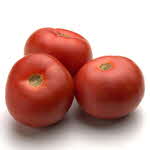Science Explains Why Tomatoes Grow BigWild tomatoes are often small, round berriesBy Stacy Kish, CSREES Staff
October 27, 2008 With high hopes and shopping basket in hand, many consumers search for that classic icon of summer-the perfect, round, ripe tomato. Many are unaware, however, that this fruit was not always so robust.
Scientists in New York* have done their part to ensure consumers get their fill by unlocking the genetic secrets that control inherited traits important to growing the classic tomato. 
Tomatoes
Photo credit: South Dakota
Department of Health
|
|
Using selective breeding, early agricultural workers domesticated wild tomatoes by growing plants that enhanced specific traits, specifically fruit size. Wild-type tomatoes are often small, round berries, but today’s domesticated plants produce the large, round tomatoes commonly found on the store shelf.
Steven Tanksley and colleagues at Cornell University took on this largely unexplored aspect of plant development to address fruit size and shape–two major factors that control the final yield, quality, and consumer acceptability of many crops.
Scientists hope biotechnology will increase their understanding of the genetic blueprint behind natural variation. This knowledge, they believe, will help breeders improve key traits, such as yield, fruit size, nutritional value, and drought resistance, in agriculturally important crops through natural breeding techniques.
Tanksley's team used high-resolution genetic mapping to pinpoint, within the chromosome, the position of the 'large fruit' gene. "Plant transformation confirmed the results and proved that the candidate gene was actually the cause of large fruit," Tanksley said. "We identified the possible mutations responsible for the evolution of large fruit by examining the sequence of the ‘small-fruit’ allele and the ‘large-fruit’ allele."
By unraveling the molecular and developmental processes that control fruit development, the team identified and isolated key fixed positions on the tomato gene that determine the final size and shape of tomato fruit.
Tanksley believes this study is the first step toward reconstructing events that led to the domestication of fruit development. The mechanisms identified through this study will be applied to other agriculturally important crops, such as coffee, pepper, eggplant, and potato.
This study also demonstrates the feasibility of isolating the key genes involved in the domestication of crop species from their wild plant ancestors. This information is valuable to agriculture because identification of these genes could lead to advances in plant breeding and the future domestication of new crop plants. * With funding from USDA’s Cooperative State Research, Education, and Extension Service (CSREES) National Research Initiative (NRI)
CSREES funded this research project through the NRI Plant Genome program. Through federal funding and leadership for research, education, and extension programs, CSREES focuses on investing in science and solving critical issues that impact people’s daily lives and the nation’s future.
| 